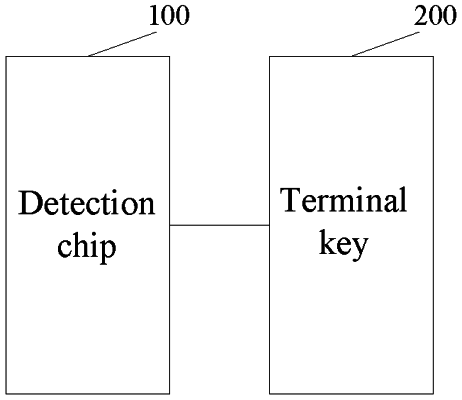| CPC G06F 3/0202 (2013.01) [G06F 3/023 (2013.01); G06F 3/0346 (2013.01); H04M 1/236 (2013.01)] | 15 Claims |

|
1. A terminal control system, comprising:
a detection chip, and at least one terminal key arranged on a side of a terminal device, wherein
the detection chip is connected to each of the at least one terminal key;
each of the at least one terminal key is configured to generate an inductive capacitance and an interelectrode capacitance corresponding to an external control instruction, in response to a reception of the external control instruction; and
the detection chip is configured to detect the inductive capacitance and the interelectrode capacitance; determine inductive capacitance variation corresponding to the inductive capacitance and interelectrode capacitance variation corresponding to the interelectrode capacitance; determine a control type corresponding to the control instruction according to the inductive capacitance variation and the interelectrode capacitance variation; and trigger the terminal device to perform a control operation corresponding to the control type;
wherein the detection chip comprises a trigger module, the trigger module is configured to:
in a case that the inductive capacitance variation is greater than a preset first threshold and the interelectrode capacitance variation is greater than a preset second threshold, determine that the control type corresponding to the control instruction is a user pressing control, and trigger the terminal device to perform a pressing control operation corresponding to the user pressing control; in a case that the inductive capacitance variation is not greater than the first threshold and the interelectrode capacitance variation is greater than the second threshold, determine that the control type corresponding to the control instruction is a mechanical pressing control, and no trigger the terminal device to perform any control operation; in a case that the inductive capacitance variation is greater than the first threshold and the interelectrode capacitance variation is not greater than the second threshold, determine that the control type corresponding to the control instruction is a user touch control, and trigger the terminal device to perform a touch control operation corresponding to the user touch control; and in a case that the inductive capacitance variation is not greater than the first threshold and the interelectrode capacitance variation is not greater than the second threshold, determine that the control type corresponding to the control instruction is a mechanical touch control, and no trigger the terminal device to perform any control operation.
|